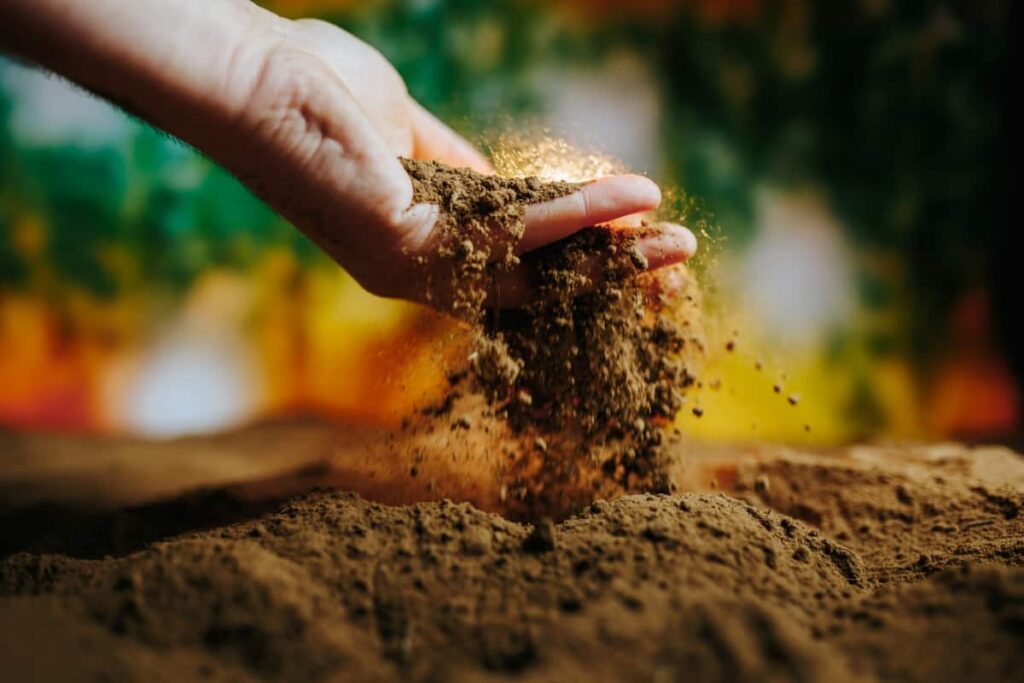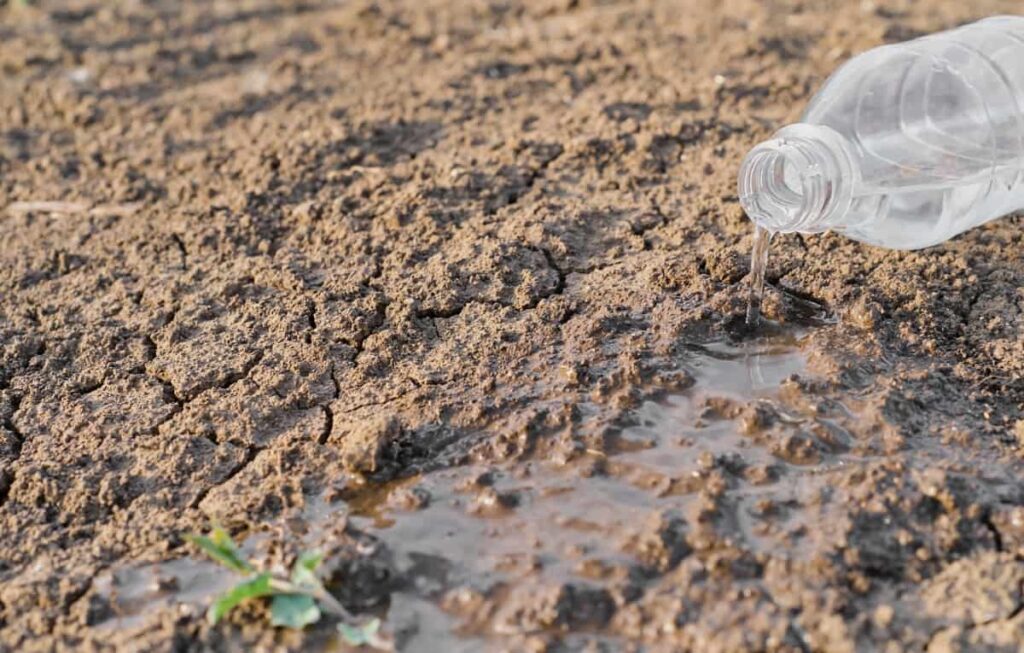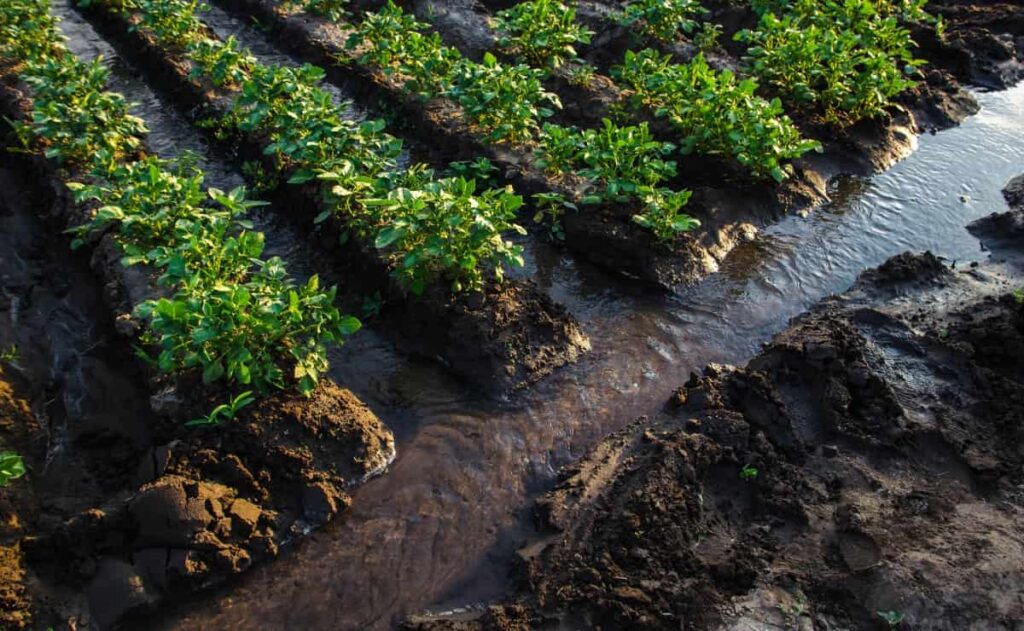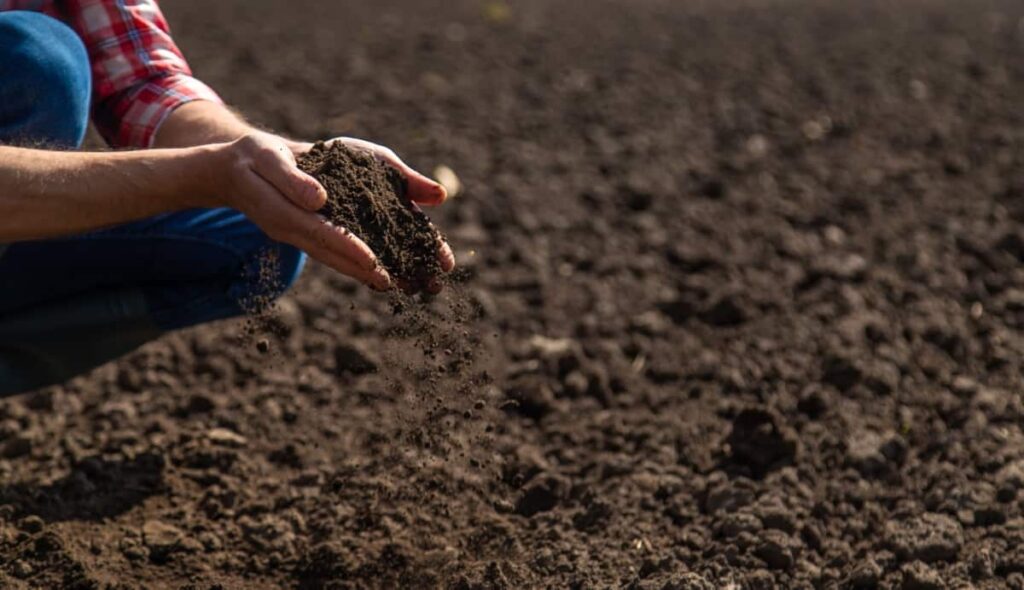Soil is the major factor for plant growth and provides nutrients, support, and water to plants. Different soil types’ water-holding capacities allow for tailored irrigation practices that promote efficient water usage and healthy plant growth. Understanding the diverse soil types and their water-holding capacity can benefit gardeners, farmers, and environmental enthusiasts. Knowing which soil type you have can help you tailor your watering schedule more efficiently.

Sandy Soils: Characteristics and Water Holding Capacity
Sandy soils are known for their coarse texture, allowing water to pass through quickly. This type of soil is light and easy to work with but cannot retain moisture for plants. Due to its large size, sandy soil has low water holding capacity, and nutrients can easily leach away. Plants grown in sandy soils may need more frequent watering than other soil types.
To improve water retention in sandy soils, adding organic matter can help enhance their ability to hold onto moisture. Irrigating slowly and deeply can also help maximize water absorption by the roots. Despite their challenges, sandy soils have benefits such as good aeration and drainage, which can be advantageous for certain plant species that prefer well-drained conditions.
Clay Soils: Water Retention and Management Strategies
Clay soils are known for their ability to retain water due to their fine particles and high plasticity. These soils can hold onto moisture well, making them beneficial for certain types of plants that thrive in consistently moist environments. However, excessive water retention in clay soils can lead to issues like poor drainage and compaction, which negatively affect plant growth.
To manage these challenges, incorporating organic matter into the soil can improve its structure and increase drainage capabilities. Implementing raised beds or mounding the soil can also help with excess water runoff and prevent waterlogging. Additionally, practicing crop rotation and avoiding overwatering can maintain a healthy balance of moisture in clay soils.
Loamy Soils: Ideal Properties for Water Conservation
Loamy soils have a balanced mixture of sand, silt, and clay particles. This blend gives loam its ideal properties for water conservation. With moderate drainage capabilities and excellent moisture retention, loamy soils are highly valued in agriculture and gardening. The crumbly texture of loam allows for proper aeration while also preventing excessive water runoff.
In case you missed it: How to Fix Sulfur Deficiency in Plants/Soil: Preventing Naturally, Organically, and Chemically

This balance is crucial in maintaining an adequate supply of water for plant roots without causing waterlogging issues. Gardeners favor loamy soils because they can retain nutrients and support healthy root development. The structure of loam promotes strong plant growth by providing a stable environment with consistent moisture levels.
Peat Soils: High Water Holding Abilities and Challenges
Peat soils are renowned for their exceptional water-holding capabilities, making them valuable in agriculture and horticulture. These soils consist of partially decomposed organic matter, which creates a sponge-like structure that retains moisture effectively. Due to their high water retention capacity, peat soils can help plants withstand dry periods and reduce the need for frequent watering.
However, despite their advantages, peat soils also present challenges. Their slow drainage properties can lead to waterlogging issues if not managed properly. This excess moisture can hinder root development and promote the growth of anaerobic bacteria harmful to plant health.
Silt Soils: Texture, Permeability, and Moisture Retention
Silt soils, known for their fine texture, fall between sand and clay according to particle size. Due to their intermediate nature, silt soils offer a balance of drainage and water retention capabilities. The small particles allow for good moisture retention while still enabling adequate permeability.
With moderate porosity, silt soils can hold onto moisture without becoming too waterlogged. Their ability to retain nutrients is also beneficial for plant growth. However, managing water content in silt soils is crucial as they have the potential to compact easily.
Chalk Soils: Drainage Properties and Irrigation Needs
Chalk soils, known for their high pH levels, possess unique drainage properties that impact irrigation requirements. These soils have excellent permeability due to their coarse texture, allowing water to move through them easily. However, this fast-draining nature can also lead to water and nutrient leaching if not managed effectively.
In case you missed it: The Importance of Soil Health in Farming: Role of Soil in Sustainable Agriculture

When irrigating chalk soils, it’s crucial to monitor moisture levels closely, as rapid drainage can cause fluctuations in soil moisture content. Drip irrigation systems are often recommended for these soil types as they deliver water directly to the roots while minimizing wastage. Additionally, planting cover crops can reduce erosion and improve water infiltration rates.
Organic Matter Influence on Water Holding Capacity
Organic matter in soil plays a crucial role in influencing water-holding capacity. Decomposing organic materials activates beneficial microorganisms, enhancing soil structure and porosity. This allows for better water infiltration and storage within the soil profile. The humus created from organic matter acts as a binding agent, helping to prevent erosion and improve overall soil quality. Additionally, organic matter increases the cation exchange capacity of the soil, promoting nutrient retention and availability for plants.
Regularly adding compost or mulch can significantly improve water retention capabilities in sandy soils while also reducing runoff and evaporation rates. Organic matter creates a healthy environment for earthworms and other beneficial organisms that aid in maintaining optimal moisture levels throughout the growing season.
Techniques for Enhancing Water Retention in Various Soils
The effective method is adding organic matter, it improves soil structure and ability to hold onto moisture. Another approach is mulching, a simple yet powerful way to reduce evaporation and maintain soil moisture levels. Mulch also helps regulate soil temperature, creating a more hospitable environment for plant roots.
In case you missed it: The Influence of Soil pH on Fertilizer Management and Nutrient Cycling: Key Considerations

Consider practicing contour plowing or terracing on sloped landscapes to minimize water runoff and promote infiltration. By controlling erosion, these techniques contribute to better water retention in the soil. Furthermore, implementing cover crops can not only protect the soil from drying out but also increase organic content over time. This results in improved water-holding capacity and overall soil health.
Impact of Soil Texture and Structure on Water Availability
Understanding the impact of soil texture and structure on water availability is crucial for efficient water management in agriculture. Sandy soils, characterized by large particles, have low water retention capacity due to their high drainage rates. In contrast, clay soils with small particles hold onto water tightly but can lead to waterlogging issues if not managed properly.
Loamy soils strike a balance between sand and clay, offering good drainage while retaining moisture well. Peat soils have high levels of organic matter and excel at holding water; however, they can be challenging to work with due to their tendency to compact over time. Silt soils fall between sand and clay in particle size, influencing both permeability and moisture retention abilities.
Chalky soils have excellent drainage properties but may require more frequent irrigation. Understanding soil types and their water-holding capacity is crucial for various agricultural and environmental applications. Different soil types, like sandy, loamy, and clayey soils, exhibit distinct characteristics that directly impact their ability to retain and release water.
- Profitable Village Farming Business Ideas in 2024
- High-Yield Aquaculture: Fast-Growing Fish for Farming
- Effective Fish Pond Construction Techniques for Beginners
- Irrigation and Water Management in Pineapple Farming
- Blossom to Harvest: Mastering Flowering and Pollination in Papaya Farming
- Pig Fattening Essentials: From Selection to Sale for Beginners
- Raising Wagyu Cattle: A Complete Guide for Premium Beef Production
- Soil Types and Their Water Holding Capacity
- Optimizing Irrigation Schedules for Coconut Groves for Enhanced Yield
